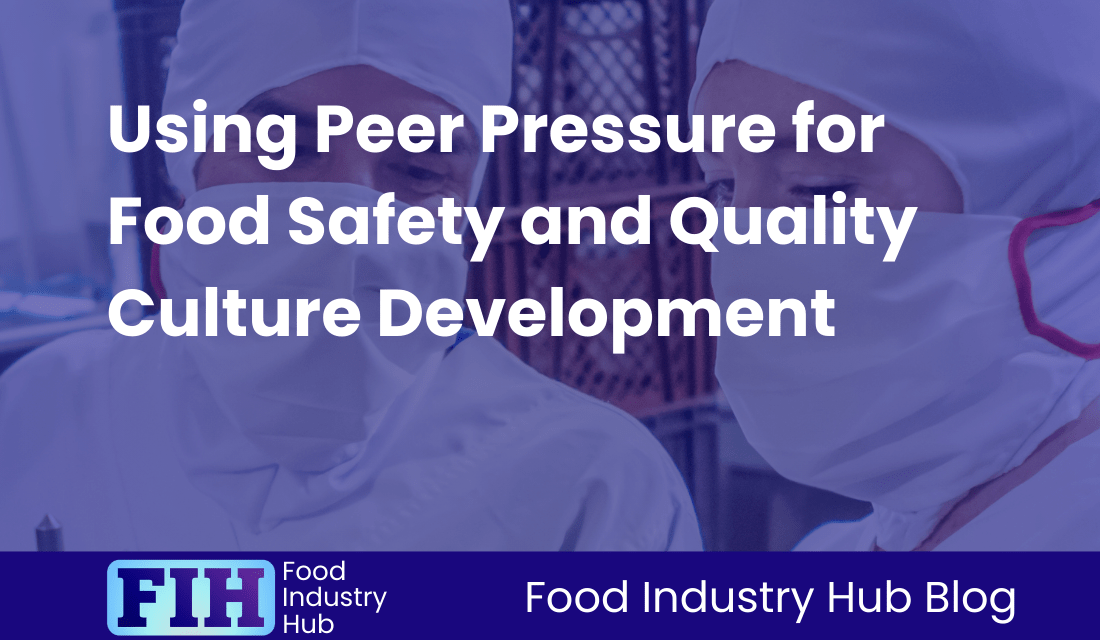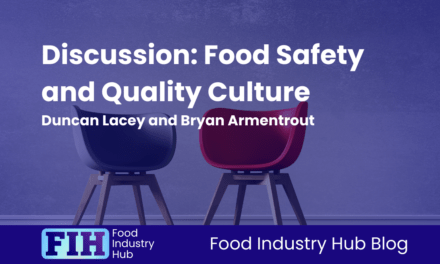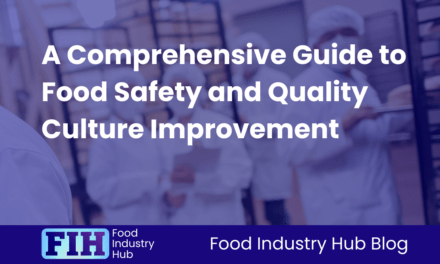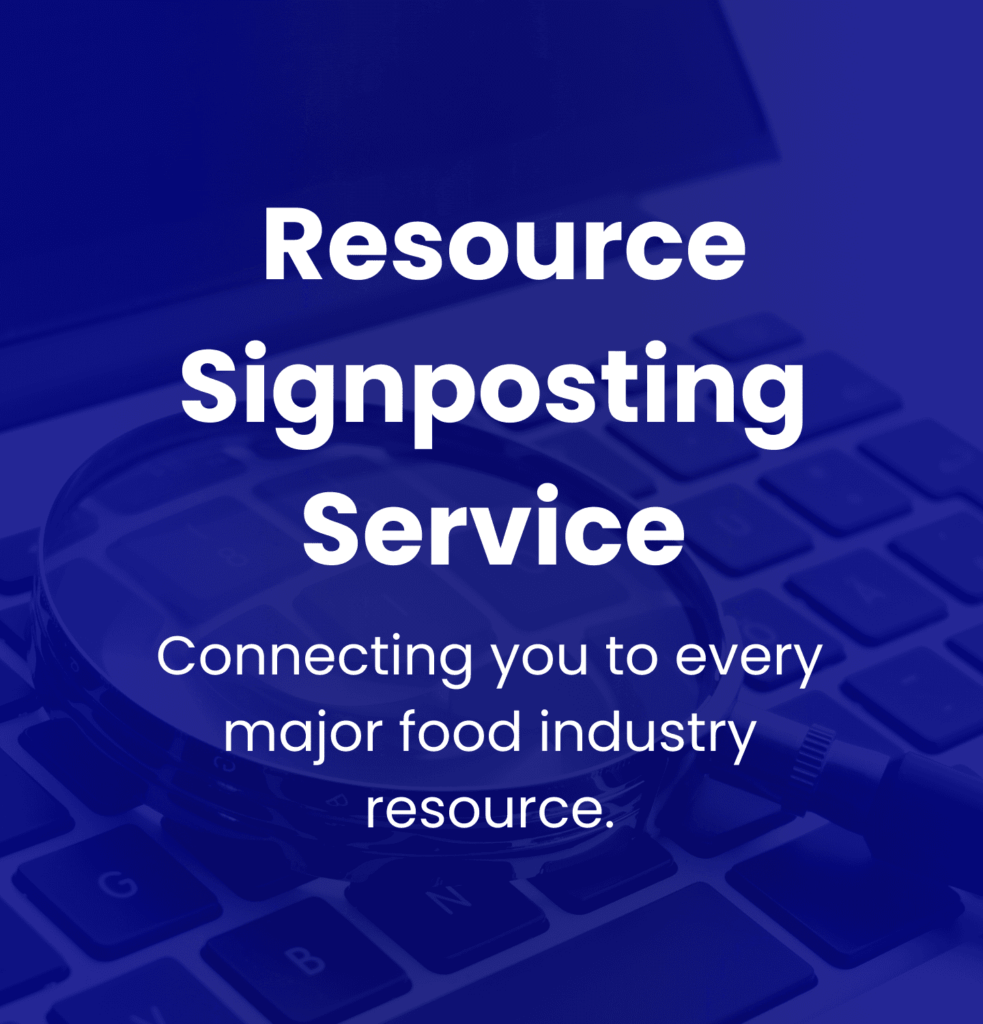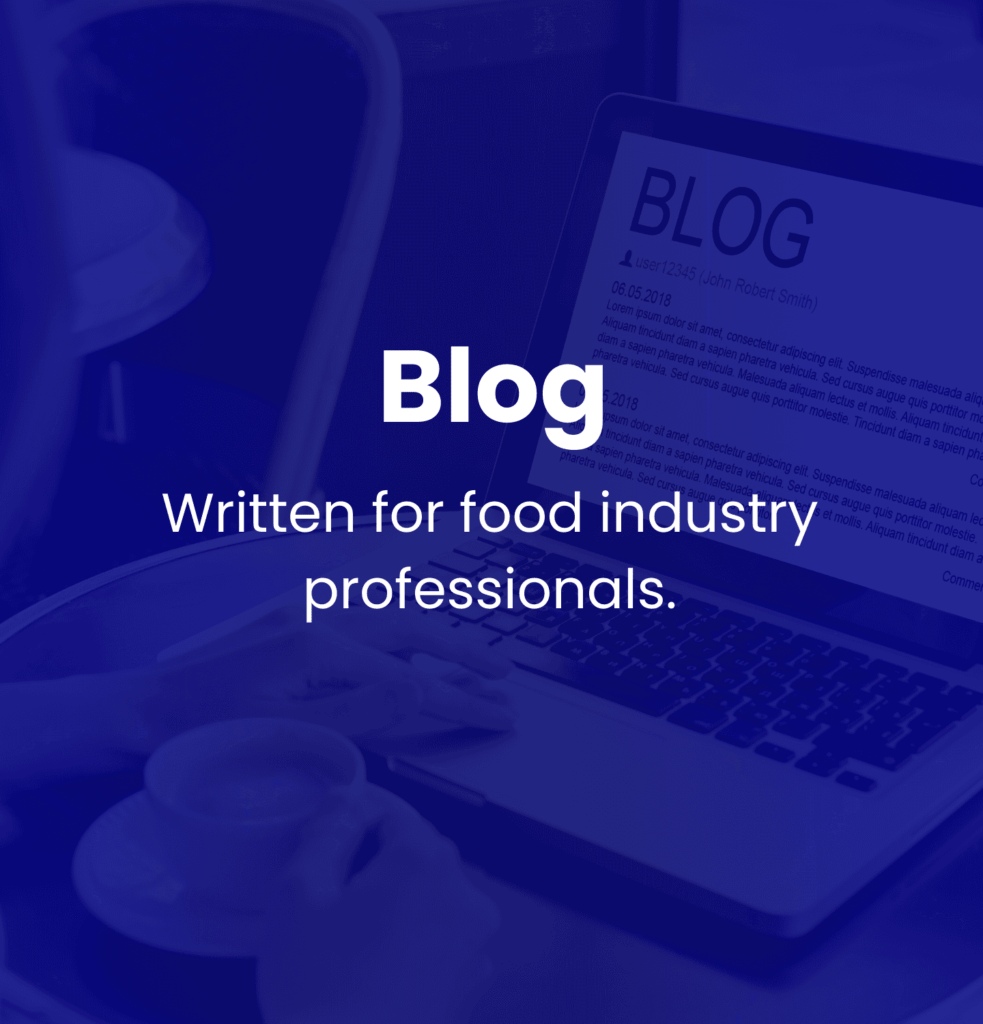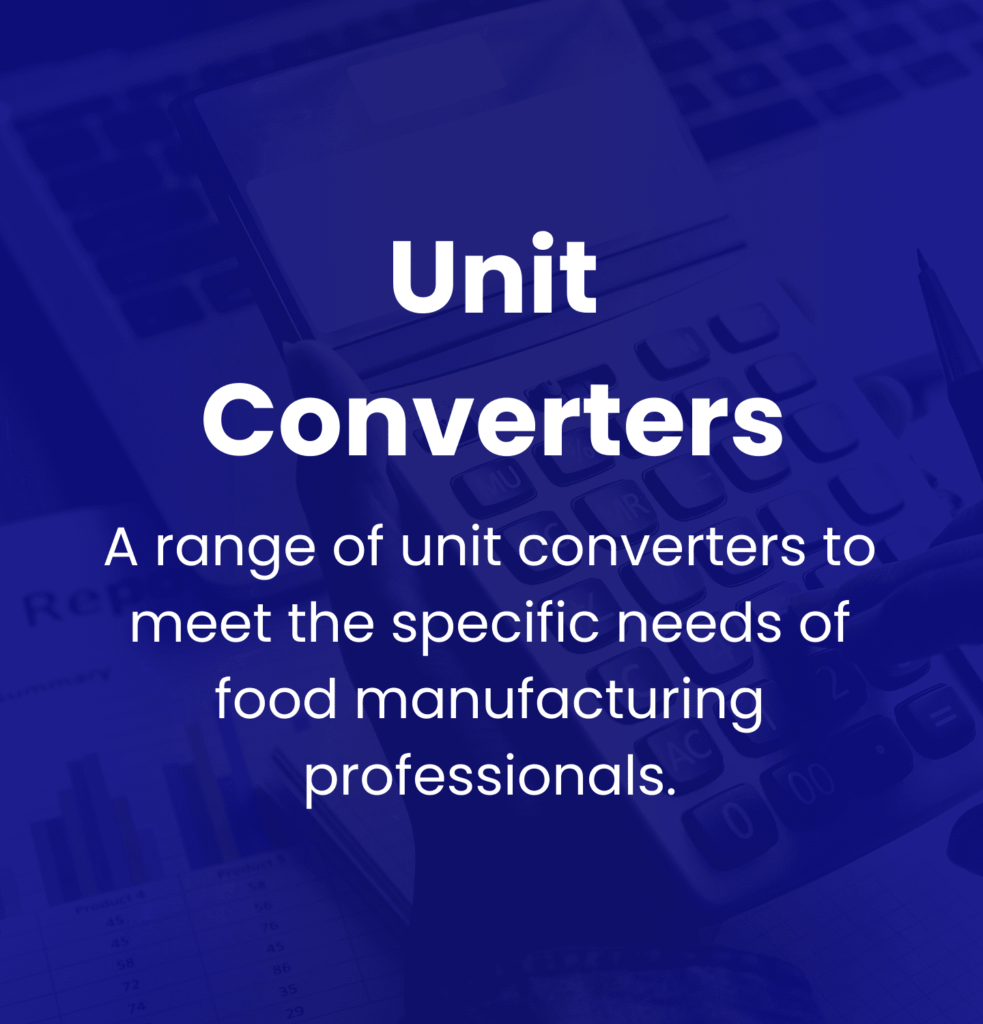Introduction
Consider the power of positive peer pressure in shaping the culture of food safety and quality in your organisation. You’ve seen how it can sway behaviours in other aspects, but have you ever considered harnessing it to encourage adherence to food safety protocols? Imagine a workplace where each team member not only understands the rules but also actively promotes them, creating an atmosphere of shared responsibility. Would you be curious to know how this can be achieved and what benefits it could bring? Well, let’s explore this further.
This post is part of a collection we’ve put together to explore the topic of food safety and quality culture, and you can explore the topic in more detail by browsing the related content.
Table of Contents
Key Takeaways
- Positive peer pressure fosters adherence to food safety standards and promotes a quality-centric culture in food manufacturing.
- Peer recognition and positive reinforcement strengthen commitment to safety protocols and inspire modelling of safe food handling practices.
- Leadership role modelling and recognition play a critical role in shaping team perception towards food safety and quality.
- An ownership mindset, reinforced by clear team-based goals and accountability, enhances personal responsibility towards food safety.
- Continuous learning and improvement, along with transparency in actions and open communication, further reinforce a strong food safety culture.

How Peer Pressure Influences Culture and Behaviours in Food Manufacturing
Peer pressure, often viewed negatively, can actually play a pivotal role in shaping the culture and behaviours in food manufacturing. You might be surprised to hear this, but it’s true. The food manufacturing industry is one where standards matter, and peer pressure is a powerful tool to ensure everyone adheres to those standards.
Let’s think about a typical scenario. You’re part of a team responsible for producing a popular food item. One day, you notice a fellow worker cutting corners, maybe not following the strict hygiene protocols deemed essential by your company. How do you react? You could turn a blind eye, but you know that’s not right. So, you remind your colleague about the importance of food safety, thus applying a form of peer pressure to maintain standards.
This is a positive use of peer pressure. It’s not about bullying or coercion but about promoting a culture of quality and safety. When everyone in the team knows they’re accountable to each other, they’re more likely to uphold the high standards that are expected, resulting in safer, higher quality food products.
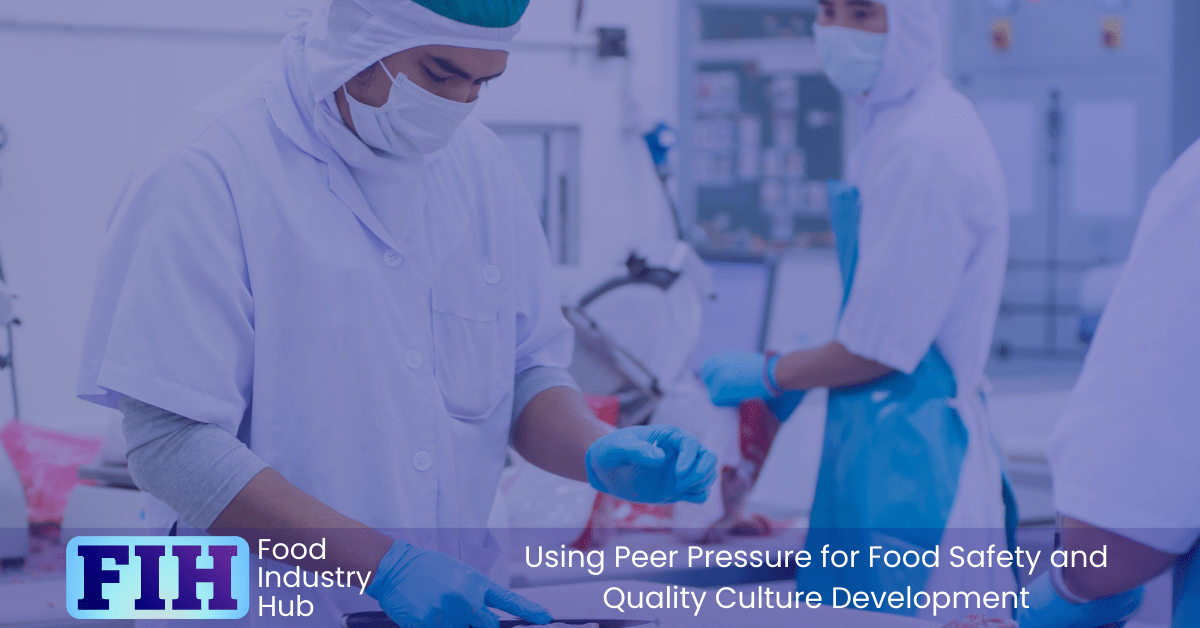
Group Influences on Individual Behaviours
You’re about to see how group dynamics can sway individual behaviours, particularly in the realm of food safety.
We’ll explore how social feedback can shape attitudes and actions.
You’ll also learn how group incentives and peer pressure can drive adherence to commonly held values.
Social Feedback and Reactions to Attitudes and Expressions
How does the group you’re part of influence your food safety behaviours? The answer lies in social feedback and reactions to attitudes and expressions.
You’re influenced by the opinions and attitudes of those around you. If your peers are dismissive of food safety rules, you might find yourself adopting a similar attitude, even if unconsciously.
Your friends’ reactions to your expressions about food safety could also affect you. If you express concern about food hygiene and receive ridicule or indifference in response, you may be less likely to voice such concerns in the future. You might even begin to question the validity of your concerns, eroding your commitment to food safety.
Conversely, if your circle exhibits a positive attitude towards food safety, you’re more likely to adopt the same approach. Having your expressions received with interest or shared concern can foster a sense of responsibility and adherence to food safety protocols.
Therefore, it’s important to surround yourself with people who value food safety and encourage a positive culture around it. Remember, the attitudes and reactions of those in your group can significantly shape your approach to food safety.
Social Feedback and Reactions to Actions and Behaviours
Shifting our focus slightly, let’s consider how the actions and behaviours of your group can influence your own when it comes to food safety.
You’re more likely to adopt safe food practices if you see your peers are doing the same. This is due to a phenomenon known as social proof, where you look to others to guide your own actions.
For example, if your colleagues are diligent about washing their hands before handling food, you’re likely to follow suit. You’ll see it as the norm, the standard behaviour expected in your working environment. The same applies to wearing appropriate attire, cleaning surfaces, and storing food properly. Their consistent actions, combined with positive feedback, can have a significant impact on your own behaviour.
However, this group influence can also work negatively. If your peers exhibit careless food handling practices, you might adopt these unsafe behaviours, thinking it’s acceptable or even the norm.
That’s why it’s essential to surround yourself with people who prioritise food safety. Their actions and attitudes will inevitably influence your own, shaping your behaviour in a way that promotes a robust food safety culture.
Group Incentives and Peer Pressure Toward Commonly Held Values
Undeniably, a group’s shared values and incentives can powerfully sway your individual behaviours, particularly in the realm of food safety. When you’re part of a team that values high standards of hygiene and quality, you’re more likely to adopt these values. This is the power of positive peer pressure.
Consider working in a factory where everyone washes their hands diligently, maintains clean workspaces, and ensures food is handled appropriately. You’ll feel compelled to do the same, not just to fit in, but also because these actions are recognised and rewarded. The group’s collective commitment acts as a nudge, gently guiding your behaviour towards better food safety practices.
Group incentives can reinforce these behaviours. When your team’s efforts lead to fewer foodborne illnesses or positive audit outcomes, rewards such as bonuses or recognition can strengthen the group’s commitment to food safety. You naturally want to contribute to this success, further cementing these habits.

Influential Individuals Steering Group Attitudes and Peer Pressure
You’ve seen how groups can shape individual behaviours.
Now, consider the role of key individuals within these groups.
Think about how their influence can be harnessed to promote food safety and quality.
Socially Influential Individuals
Influential individuals within a group can use peer pressure positively to promote food safety. You see, individuals who possess social influence have the power to shape group norms and behaviours. They’re trendsetters, opinion leaders, and they can direct the collective attitude towards food safety and quality.
The pressure to conform can lead to positive change in attitudes, behaviours, and ultimately, food safety culture. Moreover, these individuals can lead by example, showing others the correct way to handle food, clean workspaces, or store ingredients.
Individuals can also use their influence to encourage continuous learning and improvement, fostering a team culture that values safety, quality, and excellence. Remember, peer pressure doesn’t have to be negative. When harnessed by the right individuals, it can serve as a powerful tool for promoting food safety and quality.
Hierarchically Influential Individuals
In a similar vein, hierarchically influential individuals, such as managers or team leaders, can leverage their authority to steer group attitudes and channel peer pressure towards promoting food safety. They’re often seen as role models, and their attitudes and behaviours significantly impact the team’s perception of food safety.
You, as a leader, have the power to create a positive food safety culture. Your commitment to food safety can inspire your team to adopt similar attitudes. You can set high standards, emphasise the importance of every individual’s role in maintaining food safety, and praise team members who adhere to these standards. This isn’t about instilling fear of penalties, but about creating an environment where everyone understands the importance of their role in ensuring food safety and is motivated to perform their best.
Remember to lead by example. If you show a lackadaisical attitude towards food safety, your team is likely to follow suit. But if you consistently demonstrate a serious commitment to food safety, your team will respect and emulate your approach. Thus, you can positively influence your team’s food safety culture through your actions and expectations.
Capitalising On Influence for Food Safety and Quality Reinforcement
Now, let’s delve into how you can capitalise on your influence to reinforce food safety and quality standards within your team. As an influential individual, you’ve got the power to shape your team’s attitudes towards food safety and quality.
Your role as a leader is crucial. You’re not just enforcing rules, you’re setting a standard. Your team looks to you for direction, so it’s vital that you model best practices. Show them that you’re committed to maintaining quality and safety at all times.
Use positive peer pressure to your advantage. Encourage team members to hold each other accountable. Foster a culture where it’s not just about following rules, but about caring for the safety and well-being of others.
Remember, reinforcement is key. Regularly remind your team about the importance of food safety and quality. Recognise and reward those who consistently adhere to high standards. This not only boosts morale but also reinforces the right behaviours.
Don’t underestimate the power of your influence. Use it wisely to steer your team towards a culture that values food safety and quality. After all, it’s not just a matter of compliance; it’s about safeguarding the health of those we serve.
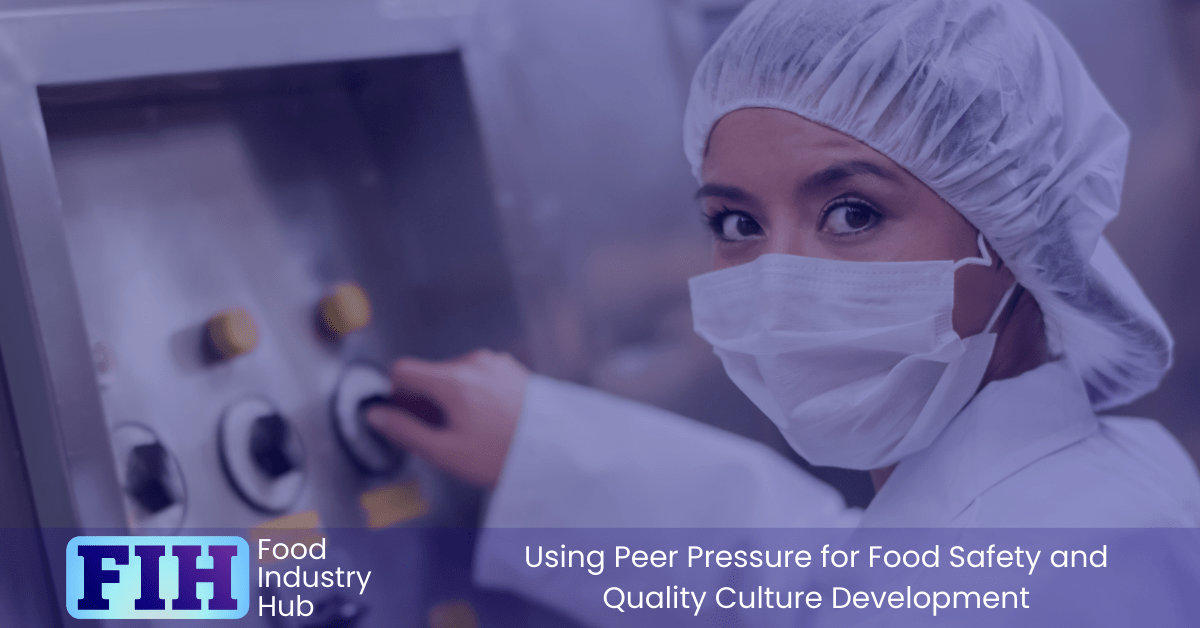
Sign-up for the Food Industry Hub Mail Service
We regularly produce new content for food industry professionals, and the Food Industry Hub Mail Service is the best way to stay up to date with the latest additions.
Signup today to be added to the Food Industry Hub mailing list.
Leadership Influence
As a leader, your actions can have a significant impact on food safety.
By demonstrating good habits – like washing hands and upholding good manufacturing practices – you’re not just talking about safety, you’re living it.
It’s this authenticity and visible commitment that can influence and encourage your team to follow suit.
Lead By Example
You’re not just a leader but a role model, so demonstrating proper food safety practices can have a significant impact on your team’s behaviour. When you adopt and consistently demonstrate food safety protocols, it sends a clear message to your team. It tells them that you’re serious about food safety and quality. It’s not just a rule to be followed, but a culture to be embraced.
Setting the bar high for yourself directly influences your team’s standards. If you’re meticulous about cleanliness, your team will be too. You’re showing them that cutting corners isn’t an option, and that quality and safety are paramount.
It’s about creating a culture where everyone understands the importance of food safety and feels responsible for it.
Role Modelling
Leading by example goes beyond just setting high standards; it involves actively role modelling the behaviours and attitudes you want your team to adopt towards food safety. You, as a leader, can have a significant influence on your team’s attitude towards food safety and quality culture development.
Role modelling isn’t about dictating rules; it’s about embodying them. You need to practice what you preach and make sure your actions align with the message you’re sending. This means adhering to all safety protocols, maintaining hygiene standards, and ensuring that all procedures are followed meticulously.
Your team looks up to you for guidance and direction. The way you handle food safety matters will shape their attitude towards it. If you show a lackadaisical approach, they might not take it seriously. Instead, if you display a strong commitment to food safety, they’re likely to follow suit.
Visibility of Actions
How visible are your actions when it comes to food safety protocols? Are you making your commitment to these practices clear for everyone to see? This is absolutely crucial. If you’re a leader in the food industry, your actions need to be as transparent as a glass window.
Your team members are watching, and they’ll follow your lead. If you’re consistently visible in your adherence to food safety standards, you’re setting a great example. You’re showing that these protocols aren’t just company rules—they’re a part of the company culture. You’re demonstrating that you value not just the end product, but the process and the people involved in it.
But it’s not just about being seen. It’s about actively promoting food safety and quality culture. It’s about encouraging open and honest communication. It’s about fostering an environment where everyone feels comfortable speaking up about safety concerns.
Authenticity and Commitment
In the realm of food safety, your authenticity and commitment as a leader are two indispensable ingredients for creating a culture that prioritises safety and quality.
You’re not just managing a team; you’re shaping an environment that directly impacts consumer health. Your commitment is a beacon. It’s your consistency in upholding food safety standards that builds trust within your team.
Your authenticity is your unique selling point. It’s the spirit behind your actions, the truth in your words, and the heart in your decisions.
When you’re authentic, you’re not pretending. You’re not just ticking off boxes in a safety checklist; you’re genuinely invested in the well-being of your consumers. And your team will pick up on that. It sets the tone for the workplace, creating an atmosphere of genuine care and responsibility.
Your commitment is your unwavering dedication to the cause. It’s not about doing just enough to avoid trouble; it’s about going the extra mile to ensure safety. It’s about being proactive, not reactive.
When you’re committed, you’re not just leading a team, you’re leading a movement for better food safety and quality culture.

Promoting Buy-In for Food Safety and Quality Ideals Throughout a Social or Organisational Group
You’re about to see how positive reinforcement can drive a group’s commitment to food safety.
Think about the power of peer recognition, esteem, and status in promoting these important ideals.
It’s all about fostering team-based goals and an ownership mindset, where everyone’s on board and invested in the cause.
Positive Reinforcement
Leveraging the power of positive reinforcement, let’s drive home the importance of adhering to food safety and quality standards in our social or organisational groups.
Positive reinforcement is an effective tool that can be used to encourage and establish a strong food safety culture within your organisation. Think of it as a reward system where you recognise and reward actions that align with food safety and quality ideals.
You’re not just telling people what to do; you’re showing them the benefits of doing it right. By doing this, you’re not just creating a culture of compliance, but one of commitment.
Positive reinforcement can be anything from verbal acknowledgement to tangible rewards. However, it’s important that the reinforcement is immediate, consistent, and meaningful to the recipient. It’s not about bribery; it’s about showing appreciation for a job well done.
But remember, positive reinforcement isn’t just a one-off thing. It’s a continuous process that needs to be integrated into your daily operations. It’s about creating an environment where good behaviour is encouraged and rewarded, and poor behaviour is actively discouraged.
Peer Recognition and Praise
Building on the idea of positive reinforcement, let’s now focus on the role of peer recognition and praise in promoting food safety and quality ideals in your group.
It’s important to realise that people often model their behaviour after those they respect and admire. So, when peers publicly recognise and praise adherence to food safety standards, it can inspire others to follow suit.
Imagine a team member takes extra steps to ensure a work area is well cleaned and sanitised. By acknowledging their effort openly, you’re not only encouraging their positive actions, but you’re also setting a standard for others. It’s a powerful way to reinforce the value of food safety and quality measures.
Praise doesn’t have to be grandiose. Small, consistent affirmations can do wonders. A simple ‘well done’ or ‘great job’ can go a long way. Remember, the objective is to foster a supportive environment where everyone strives for safety and quality.
In essence, peer recognition and praise can be instrumental in shaping a food safety culture. It’s an approach that combines social influence with positive reinforcement, effectively promoting the importance of food safety and quality within your group.
Esteem and Status
In an organisational setting, your status and esteem can play a critical role in fostering a culture that values food safety and quality ideals. As a leader, your actions and attitudes towards these ideals can significantly influence your team’s commitment to them.
It’s essential to understand that your team members look up to you. They observe your actions, emulate your behaviours, and are influenced by your attitudes. If you demonstrate a high regard for food safety and quality, your team is more likely to do the same.
But it’s not just about your actions. You also need to verbally communicate the importance of these ideals. Talk about food safety and quality in team meetings, one-on-one conversations, and even in casual chats. Make these topics a standard part of your communication.
Additionally, use your status to recognise and reward those who adhere to food safety and quality standards. This not only reinforces their behaviour but also sets an example for others to follow.
Team-Based Goals
To truly create a culture of food safety and quality, you’ll need to establish team-based goals that encourage everyone’s commitment. These goals should be clear, concise, and achievable, fostering mutual understanding and shared responsibility within the team. The idea is to create a common vision that everyone can get behind, where each member sees their role in achieving the larger goal.
Team-based goals encourage accountability and enhance cooperation among team members. It’s important that these goals are reinforced with the right incentives.
Recognise and reward your team’s efforts towards achieving these goals. Celebrate their successes, no matter how small. Not only will this motivate your team, but it also instils a sense of pride in their work, further reinforcing the culture of food safety and quality.
Ownership Mindset
Cultivating an ownership mindset towards food safety and quality among your team is the next progressive step. This means promoting a culture where every team member feels a personal responsibility towards food safety and quality. They’re not just following rules because they’re told to, but because they understand the importance of their role.
You’ll need to convey the message that food safety isn’t just a job requirement, but a commitment to the welfare of the consumers. It’s about ensuring every batch of product released is safe and of the best quality. This mindset shouldn’t be confined to the production area. It should permeate every corner of your organisation, from the boardroom to the delivery truck.
Encourage your team to create and implement their own safety and quality measures. This not only fosters a sense of ownership but also promotes creativity and innovation. Remember, it’s not about being a dictator enforcing rules, but a leader inspiring change.
In fostering this mindset, you’re creating an environment where everyone is a stakeholder in food safety and quality. Everyone’s input matters, and everyone’s effort counts. This is how you build a culture of excellence, one team member at a time.
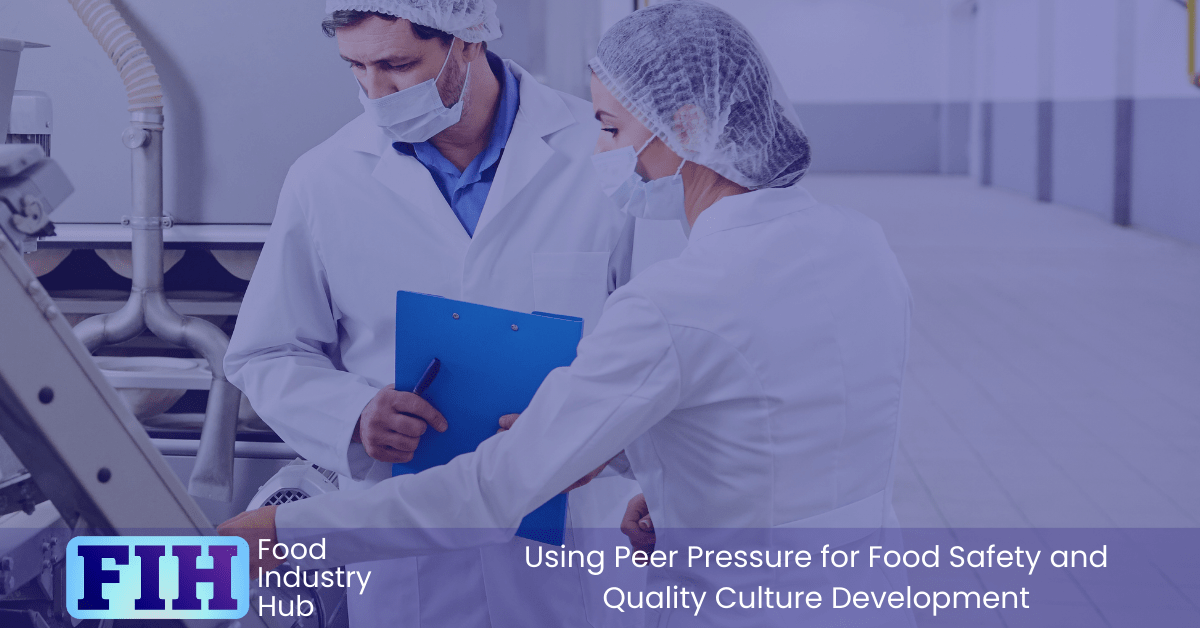
Normalising High Standards
You’ve bought into the idea of food safety; now it’s about making high standards the norm.
Consider expectations-setting, accountability, monitoring and feedback, gamification, and open communication among peers.
Let’s explore how these points can change your food safety culture for the better.
Expectations-Setting
Setting high standards for food safety becomes the new norm when you harness the power of positive peer pressure effectively. It’s about creating a culture where everyone expects nothing less than the best. You’re not just expecting high standards, but normalising them. This means making them so ingrained in your team’s mindset that they become second nature.
Clear communication is key. You’ve got to articulate these standards to your team in a way that’s easily understood. It’s not enough to just tell them what to do. You’ve got to explain why it’s important, and how each person’s role contributes to the bigger picture.
But setting expectations is just half the battle. You also need to provide the tools and resources necessary for your team to meet these standards. This could mean investing in training programs, providing up-to-date equipment, or simply making sure everyone has the information they need to do their job well.
Accountability
Once you’ve set clear expectations and provided the necessary resources, you have to hold everyone accountable for meeting these high food safety standards.
Accountability isn’t a punishment, but an opportunity for growth. It’s about fostering a culture where quality isn’t the exception, but the norm.
To create this culture, everyone in your organisation should feel responsible for maintaining high standards. When you’ve made it clear that everyone’s actions impact food safety, you’ll notice an increased commitment to quality.
Responsibility shouldn’t only fall on the shoulders of management but also on every individual. This way, you’re not only ensuring that standards are met, but also that your team feels valued and involved.
Remember that accountability isn’t something that’s just enforced from the top down. It’s a collective responsibility. This means encouraging your team to hold each other accountable. When everyone understands their role in maintaining food safety, they’ll be more likely to step up and ensure their peers are doing the same.
Monitoring and Feedback
To normalise high standards in food safety, regular monitoring and proactive feedback are essential parts of the process.
Monitoring isn’t just about ticking boxes; it’s about understanding what’s happening on the ground. You need to be on the lookout for both positive practices and areas that need improvement.
Feedback is the backbone of continuous improvement. It’s not enough to just notice when things aren’t up to par. You’ve got to communicate it effectively and in a timely manner. Remember, it’s a two-way street. Encourage your staff to share their thoughts and observations too. They’re the ones on the front lines, and their input is invaluable.
But don’t stop at pointing out the negatives. Positive reinforcement is also key. When you see someone adhering to high safety standards, acknowledge it. This not only boosts morale but also encourages the replication of these good practices.
Gamification
Incorporating gamification into your food safety program can be a game-changer, making adherence to high standards more engaging and fun for your team. This approach transforms mundane tasks into interactive challenges, sparking a competitive spirit that can drive better compliance with food safety rules.
Think about setting up a leaderboard to track and reward staff who consistently meet or exceed quality standards. This could be as straightforward as recognising those who consistently wear their hairnets or those who excel at maintaining clean workspaces.
You could also consider introducing badges or certifications for completing food safety training or mastering certain skills. These rewards not only motivate your team, but also help normalise high standards in your workplace.
When you make it fun to follow the rules, you’re creating a culture where food safety is a shared responsibility, not a chore.
Open Communication Among Peers
Building on the idea of gamification, fostering open communication among your team can further solidify the normalisation of high food safety standards.
Encourage team members to voice their concerns, share ideas, and engage in discussions about food safety. This open dialogue can break down barriers, bolster a sense of community, and make everyone feel part of the process.
One way to facilitate this is through regular team meetings. These shouldn’t be a one-way street of management issuing directives. Instead, they should be interactive sessions where everyone’s feedback is valued. You’ll discover that when employees feel their opinion matters, they’re more motivated to uphold safety standards.
Simultaneously, create a safe space for employees to report issues without fear of repercussions. This can be a suggestion box, an anonymous hotline, or a designated person they can confide in
You’ll find that this transparency doesn’t just improve safety — it also boosts morale and trust within your team.
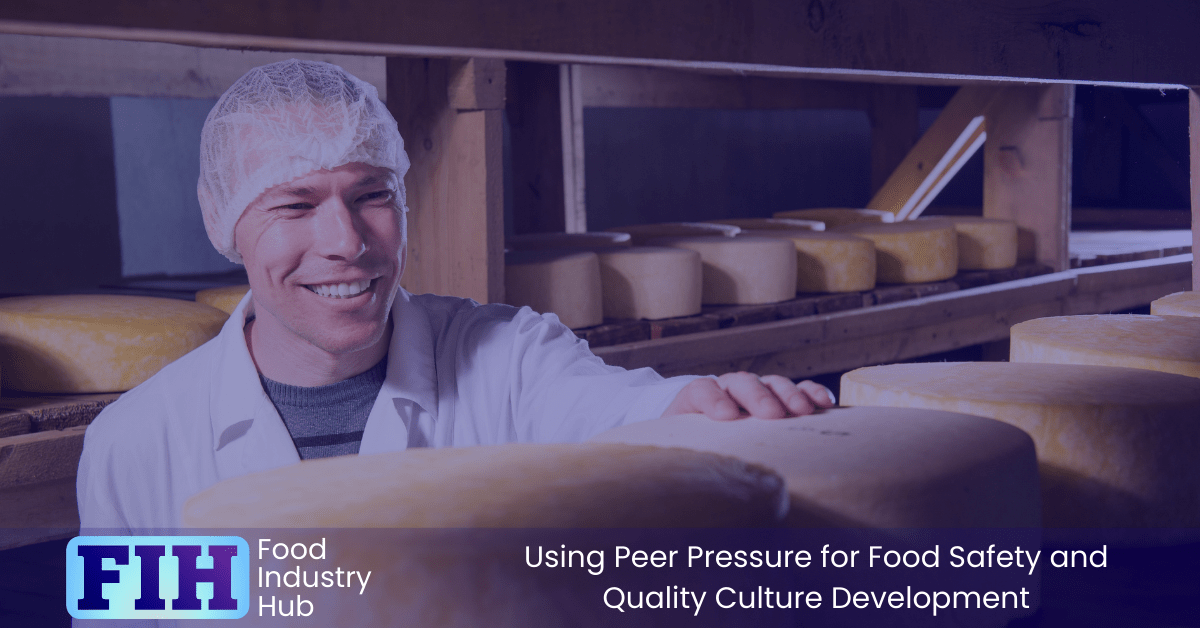
The Importance of Peer Pressure in Contributing to A Culture of Food Safety and Quality
Harnessing the power of positive peer pressure can significantly improve your commitment to food safety and quality. When you’re part of a team that prioritises these standards, you’re more likely to adopt those same habits. It’s human nature to want to fit in and be accepted by your peers. Utilising this innate desire can be the key to creating a culture of high-quality food production and safety.
Imagine being on a production line where everyone meticulously follows hygiene protocols. The likelihood is you’ll also wash your hands regularly, wear appropriate PPE, and take necessary precautions to avoid cross-contamination. You wouldn’t want to be singled out as the one not adhering to the norm.
Similarly, if your peers are consistently producing high-quality food, you’ll strive to do the same. You’ll be more motivated to understand the intricacies of the ingredients, the manufacturing process, and presentation. You’ll aim to match, if not exceed, the standards set by your colleagues.
Positive peer pressure isn’t about coercion or shame. It’s about fostering a shared responsibility and commitment to food safety and quality. So, don’t underestimate its power in shaping your food production culture.

In Summary
You’re part of a team that can harness the power of positive peer pressure to foster a culture of food safety and quality.
By influencing group attitudes, normalising high standards, and promoting buy-in, you’re not just minimising risks but also boosting morale.
Remember, your commitment to excellence isn’t just about you. It’s about everyone in your organisation.
So, let’s step up, inspire each other, and collectively raise the bar in food safety and quality.
From The Food Industry Hub Knowledge Centre
Featured pages from The Food Industry Hub Knowledge Centre:
Further Resources
Food Industry Hub serves the food industry with a range of digital resources for the benefit of both commercial food manufacturers and food industry professionals.
For food manufacturers, we offer integrated management systems that give every user a direct interface with your QMS.
For food industry professionals, we provide an extensive signposting service in addition to informational content we hope you’ll find useful as you face new professional challenges. We have very ambitious plans to expand the range of services offered, and currently present informational content on management, safety and quality, food safety and quality culture, and professional success.

